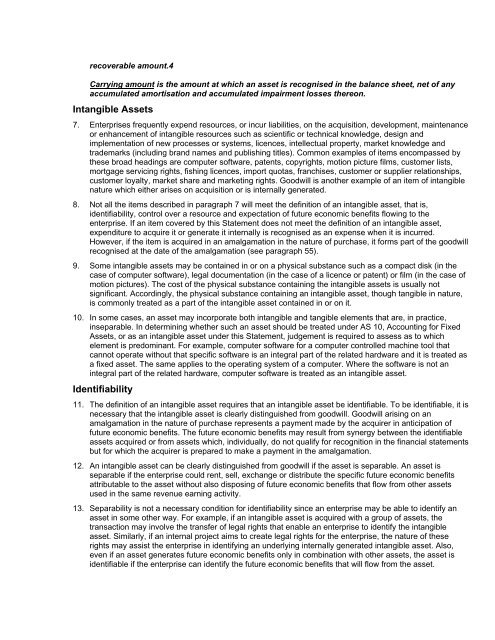Accounting Standards 1-29 - Seth & Associates
Accounting Standards 1-29 - Seth & Associates
Accounting Standards 1-29 - Seth & Associates
You also want an ePaper? Increase the reach of your titles
YUMPU automatically turns print PDFs into web optimized ePapers that Google loves.
ecoverable amount.4<br />
Carrying amount is the amount at which an asset is recognised in the balance sheet, net of any<br />
accumulated amortisation and accumulated impairment losses thereon.<br />
Intangible Assets<br />
7. Enterprises frequently expend resources, or incur liabilities, on the acquisition, development, maintenance<br />
or enhancement of intangible resources such as scientific or technical knowledge, design and<br />
implementation of new processes or systems, licences, intellectual property, market knowledge and<br />
trademarks (including brand names and publishing titles). Common examples of items encompassed by<br />
these broad headings are computer software, patents, copyrights, motion picture films, customer lists,<br />
mortgage servicing rights, fishing licences, import quotas, franchises, customer or supplier relationships,<br />
customer loyalty, market share and marketing rights. Goodwill is another example of an item of intangible<br />
nature which either arises on acquisition or is internally generated.<br />
8. Not all the items described in paragraph 7 will meet the definition of an intangible asset, that is,<br />
identifiability, control over a resource and expectation of future economic benefits flowing to the<br />
enterprise. If an item covered by this Statement does not meet the definition of an intangible asset,<br />
expenditure to acquire it or generate it internally is recognised as an expense when it is incurred.<br />
However, if the item is acquired in an amalgamation in the nature of purchase, it forms part of the goodwill<br />
recognised at the date of the amalgamation (see paragraph 55).<br />
9. Some intangible assets may be contained in or on a physical substance such as a compact disk (in the<br />
case of computer software), legal documentation (in the case of a licence or patent) or film (in the case of<br />
motion pictures). The cost of the physical substance containing the intangible assets is usually not<br />
significant. Accordingly, the physical substance containing an intangible asset, though tangible in nature,<br />
is commonly treated as a part of the intangible asset contained in or on it.<br />
10. In some cases, an asset may incorporate both intangible and tangible elements that are, in practice,<br />
inseparable. In determining whether such an asset should be treated under AS 10, <strong>Accounting</strong> for Fixed<br />
Assets, or as an intangible asset under this Statement, judgement is required to assess as to which<br />
element is predominant. For example, computer software for a computer controlled machine tool that<br />
cannot operate without that specific software is an integral part of the related hardware and it is treated as<br />
a fixed asset. The same applies to the operating system of a computer. Where the software is not an<br />
integral part of the related hardware, computer software is treated as an intangible asset.<br />
Identifiability<br />
11. The definition of an intangible asset requires that an intangible asset be identifiable. To be identifiable, it is<br />
necessary that the intangible asset is clearly distinguished from goodwill. Goodwill arising on an<br />
amalgamation in the nature of purchase represents a payment made by the acquirer in anticipation of<br />
future economic benefits. The future economic benefits may result from synergy between the identifiable<br />
assets acquired or from assets which, individually, do not qualify for recognition in the financial statements<br />
but for which the acquirer is prepared to make a payment in the amalgamation.<br />
12. An intangible asset can be clearly distinguished from goodwill if the asset is separable. An asset is<br />
separable if the enterprise could rent, sell, exchange or distribute the specific future economic benefits<br />
attributable to the asset without also disposing of future economic benefits that flow from other assets<br />
used in the same revenue earning activity.<br />
13. Separability is not a necessary condition for identifiability since an enterprise may be able to identify an<br />
asset in some other way. For example, if an intangible asset is acquired with a group of assets, the<br />
transaction may involve the transfer of legal rights that enable an enterprise to identify the intangible<br />
asset. Similarly, if an internal project aims to create legal rights for the enterprise, the nature of these<br />
rights may assist the enterprise in identifying an underlying internally generated intangible asset. Also,<br />
even if an asset generates future economic benefits only in combination with other assets, the asset is<br />
identifiable if the enterprise can identify the future economic benefits that will flow from the asset.




